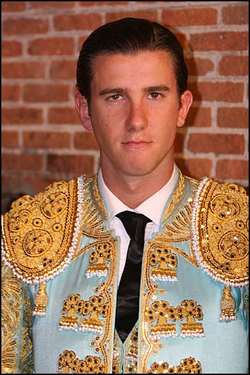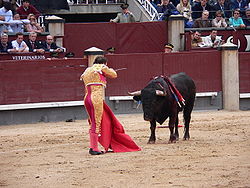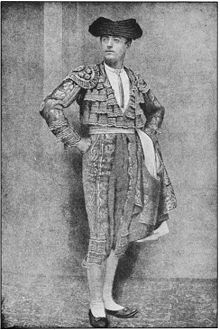- Torero
-
For the 1956 documentary film, see Torero (film).
A torero (Spanish: [toˈɾeɾo]) or toureiro (Portuguese: [toˈɾɐjɾu]) is a bullfighter and the main performer in bullfighting, practised in Spain, Colombia, Portugal, Mexico, France and various other countries influenced by Spanish culture.[1] In Spanish, the word torero describes any of the performers who actively participate in the bullfight. The main one who is the leader of the entourage and who kills the bull is addressed as maestro (master) and his formal title is matador de toros (killer of bulls) but the word "matador" by itself is only used in English and never in Spanish. The term torero encompasses all who fight the bull in the ring (picadores and rejoneadores). The other bullfighters in the entourage are called subalternos and their suits are embroidered in silver as opposed to the matador's gold.
An alternative word for torero is toreador in English (and in Bizet's opera Carmen), but this term (older than torero)[citation needed] is not used in Spain and seldom in Latin America.
A very small number of women have been bullfighters on foot or on horseback, a recent example being Cristina Sánchez. Female matadors have experienced considerable resistance and hostility from aficionados and other matadors.[citation needed]
Usually, toreros start fighting young bulls (novillos or, more informally in some Latin American countries, vaquillas), and are called novilleros. Fighting of mature bulls commences only after a special match, called "the Alternative". At this bullfight the novillero (junior bullfighter) is presented to the crowd as a matador de toros.
Bullfighting is not called or considered a sport but rather a performance art. There is no contest nor punctuation or classification.
Bullfighting historically started with nobles on horseback lancing bulls with commoners on foot doing helping jobs. As time went by the work of the commoners on foot gained in importance up to the point where they became the main and only act. Bullfighting on horseback became a separate and distinct act called "rejoneo" which is still performed although not as often as bullfighting on foot.
Bullfighting on foot became a means for poor people to achieve fame and fortune. When a famous torero was asked why he risked his life, he reportedly answered Más cornadas da el hambre ("Hunger strikes more painfully", lit. "Hunger gives more gores"). It is now common for a bullfighter to be born into a family of bullfighters.
Maletilla or espontáneo are those who illegally jump into the ring and attempt to bullfight. While the practice is widely despised, some, such as El Cordobés, start their career this way.
Contents
Types
Matador de Toros
A matador de toros (lit. "killer of bulls", from Late Latin matare, "to subdue or kill", from Classical Latin mactare) is considered to be both an artist and an athlete, possessing great agility, grace, and coordination. One of the most famous matadors was Juan Belmonte (1892–1962), whose technique in the ring revolutionised bullfighting and remains the standard by which bullfighters are judged. The style and bravery of the matador is regarded as being at least as important as whether or not he actually kills the bull. The most successful matadores used to be treated like pop stars, with a matching financial income, cult followings and accompanied by lurid tabloid stories about their conquests with women. Currently, however, even top matadors earn less in real terms than their peers did in the 1960s, and mass media coverage is limited to a handful of matadors known as the "mediáticos" and which do not include any of the top bullfighters in Spain. The danger of bullfighting adds to the matador's mystique; matadores are often injured by bulls and 52 have been killed in the arena since 1700. One of the most famous bullfighters in history, Manolete, died this way in 1947. This hazard is said to be central to the nature and appeal of bullfighting.
The American writer Ernest Hemingway aspired to be a matador. His novel The Sun Also Rises has autobiographical elements and includes bullfighting themes, as do his short stories The Capital of the World and The Undefeated. He also wrote two non-fiction books on bullfighting, entitled Death in the Afternoon (1933) and The Dangerous Summer (1959).
In 1962, Hollywood producer David Wolper produced "The Story Of A Matador", documenting what it's like to be a matador.[2] In this case, it was the late Matador Jaime Bravo.
Picador
A picador is a bullfighter who uses a lance while on horseback to test the bull's strength and to provide clues to the matador on which side the bull is favoring. They perform in the tercio de varas which is the first of the three stages in a Spanish bullfight. The shape of the lance or pica is regulated by Spanish law to prevent serious injury to the bull which was viewed as cheating in the past. The bull charges the horses in the ring and at the moment of contact the picador lances the bull in the large muscle at the back of the neck, and thus begins the work of lowering his head. The picador continues to stab the bull's neck leading to the animal's first major loss of blood. During this time, the bull's neck muscles do fatigue, however, as a result of the bull charging the picador's horse and trying to lift the horse with its horns. The loss of blood and exertion weakens the bull further and makes him ready for the next stage.
To protect the horse from the bull’s horns, the horse is surrounded by a 'peto' – a mattress-like protection. Prior to 1928, the horse did not wear any protection and the bull would frequently disembowel the horse during this stage.
French matadors will often use the battle cries "ole" (in France) "allons" to antagonise and aggravate the bull. Such a battle cry is said to instill in the chosen bull such a feverish sense of anxiety that the spectacle will become much more fiercely-contested.
Banderillero
The banderillero is a torero who sets the banderillas (lit. little flags). These are colorful sticks with a barbed point which are placed in the top of the bull's shoulder. Banderilleros attempt to place the sticks while running as close to the bull as possible. They are judged by the crowd on their form and bravery. Sometimes a matador who was a particularly skillful banderillero before becoming a matador will place some of the banderillas himself. Skilled banderilleros can actually correct faults in the manner in which the bull charges by lancing the bull in such a way that the bull ceases hooking to one side, and thereby removing a potential source of danger to the matador.
Costume
Because of the decorations and elaborateness on the costume, the Spanish call the toreador's outfit as traje de luces, meaning the "suit of lights". Though undoubtedly flamboyant, matador costume structure provides great ease of movement.
Pop Culture and other references
In 1991, professional wrestler Tito Santana adopted a Matador persona, including the nickname the "El Matador" Tito Santana and a "traje de luces" styled wrestling outfit.
The codename "Operation Matador" was used no less than six times by various armies and intelligence agencies.
See also
- Spanish-style bullfighting
- Bullfighting
- List of bullfighters
- Texas Tech Red Raiders, formerly the Texas Tech Matadors, are the athletics team of Texas Tech University
- Valencia Community College The Matador is the college's mascot.
- University of San Diego The Torero is the college's mascot.
References
Poon, Wena, Alex y Robert, Salt Publishing, London, 2010. Novel about an American teenage girl training as a matador in contemporary Spain.
External links
- "Haunted By The Horns", (2006) An ESPN online article about Matador Alejandro Amaya and Matador Eloy Cavazos. The article investigates why a matador chooses their profession.
- "Boutique del Torero", Tienda online articulos taurinos, somos fabricantes de capotes. Boutique del Torero.
- Female Matadors: A Fierce Beauty - slideshow by Life magazine
Categories:- Spanish culture
- Bullfighters
Wikimedia Foundation. 2010.



